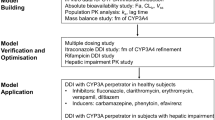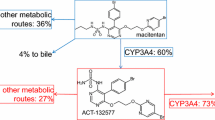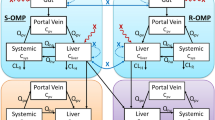Abstract
Ivabradine and its metabolite both demonstrate heart rate–reducing effect (If current inhibitors) and undergo CYP3A4 metabolism. The purpose of this study was to develop a joint parent-metabolite physiologically based pharmacokinetic (PBPK)/pharmacodynamic (PD) model to predict the PK and PD of ivabradine and its metabolite following intravenous (i.v.) or oral administration (alone or co-administered with CYP3A4 inhibitors). Firstly, a parent-metabolite disposition model was developed and optimised using individual plasma concentration-time data following i.v. administration of ivabradine or metabolite within a Bayesian framework. Secondly, the model was extended and combined with a mechanistic intestinal model to account for oral absorption and drug-drug interactions (DDIs) with CYP3A4 inhibitors (ketoconazole, grapefruit juice). Lastly, a PD model was linked to the PBPK model to relate parent and metabolite PK to heart rate (HR) reduction. The disposition model described successfully parent-metabolite PK following i.v. administration. Following integration of a gut model, the PBPK model adequately predicted plasma concentration profiles and the DDI risk (92% and 85% of predicted AUC+inhibitor/AUCcontrol and Cmax+inhibitor/Cmaxcontrol for ivabradine and metabolite within the prediction limits). Ivabradine-metabolite PBPK model was linked to PD by using the simulated unbound parent-metabolite concentrations in the heart. This approach successfully predicted the effects of both entities on HR (observed vs predicted − 7.7/− 5.9 bpm and − 15.8/− 14.0 bpm, control and ketoconazole group, respectively). This study provides a framework for PBPK/PD modelling of a parent-metabolite and can be scaled to other populations or used for investigation of untested scenarios (e.g. evaluation of DDI risk in special populations).








Similar content being viewed by others
References
Nestorov I. Whole body pharmacokinetic models. Clin Pharmacokinet. 2003;42(10):883–908.
Jones H, Chen Y, Gibson C, Heimbach T, Parrott N, Peters S, et al. Physiologically based pharmacokinetic modeling in drug discovery and development: a pharmaceutical industry perspective. Clin Pharmacol Ther. 2015;97(3):247–62.
Grimstein M, Yang Y, Zhang X, Grillo J, Huang S-M, Zineh I, et al. Physiologically based pharmacokinetic modeling in regulatory science: an update from the U.S. food and drug administration’s office of clinical pharmacology. J Pharm Sci. 2019;108(1):21–5.
Gertz M, Cartwright CM, Hobbs MJ, Kenworthy KE, Rowland M, Houston JB, et al. Cyclosporine inhibition of hepatic and intestinal CYP3A4, uptake and efflux transporters: application of PBPK modeling in the assessment of drug-drug interaction potential. Pharm Res. 2013;30(3):761–80.
de Zwart L, Snoeys J, Jong JD, Sukbuntherng J, Mannaert E, Monshouwer M. Ibrutinib dosing strategies based on interaction potential of CYP3A4 perpetrators using physiologically based pharmacokinetic modeling. Clin Pharmacol Ther. 2016;100(5):548–57.
Rodgers T, Leahy D, Rowland M. Physiologically based pharmacokinetic modeling 1: predicting the tissue distribution of moderate-to-strong bases. J Pharm Sci. 2005;94(6):1259–76.
Rodgers T, Rowland M. Physiologically based pharmacokinetic modelling 2: predicting the tissue distribution of acids, very weak bases, neutrals and zwitterions. J Pharm Sci. 2006;95(6):1238–57.
Poulin P, Theil F. Prediction of pharmacokinetics prior to in vivo studies. 1. Mechanism-based prediction of volume of distribution. J Pharm Sci. 2002;91(1):129–56.
Yau E, Olivares-Morales A, Gertz M, Parrott N, Darwich AS, Aarons L, et al. Global sensitivity analysis of the Rodgers and Rowland model for prediction of tissue: plasma partitioning coefficients: assessment of the key physiological and physicochemical factors that determine small-molecule tissue distribution. AAPS J. 2020;22(2):41.
Harwood MD, Achour B, Neuhoff S, Russell MR, Carlson G, Warhurst G, et al. In vitro–in vivo extrapolation scaling factors for intestinal P-glycoprotein and breast cancer resistance protein: part I: a cross-laboratory comparison of transporter-protein abundances and relative expression factors in human intestine and Caco-2 cells. Drug Metab Dispos. 2016;44(3):297–307.
Scotcher D, Jones C, Posada M, Galetin A, Rostami-Hodjegan A. Key to opening kidney for in vitro-in vivo extrapolation entrance in health and disease: part II: mechanistic models and in vitro-in vivo extrapolation. AAPS J. 2016;18(5):1082–94.
Zamek-Gliszczynski MJ, Lee CA, Poirier A, Bentz J, Chu X, Ellens H, et al. ITC recommendations for transporter kinetic parameter estimation and translational modeling of transport-mediated PK and DDIs in humans. Clin Pharmacol Ther. 2013;94(1):64–79.
Guo Y, Chu X, Parrott NJ, Brouwer KLR, Hsu V, Nagar S, et al. Advancing predictions of tissue and intracellular drug concentrations using in vitro, imaging and physiologically based pharmacokinetic modeling approaches. Clin Pharmacol Ther. 2018;104(5):865–89.
Rostami-Hodjegan A. Reverse translation in PBPK and QSP: going backwards in order to go forward with confidence. Clin Pharmacol Ther. 2018;103(2):224–32.
U.S. Food and Drug Administration. Cannabidiol clinical pharmacology review. [January 2020]. Available from: https://www.accessdata.fda.gov/drugsatfda_docs/nda/2018/210365Orig1s000ClinPharmR.pdf
U.S. Food and Drug Administration. Entrectinib clinical pharmacology review. [January 2020]. Available from: https://www.accessdata.fda.gov/drugsatfda_docs/nda/2019/212725Orig1s000,%20212726Orig1s000MultidisciplineR.pdf.
U.S. Food and Drug Administration. Doravirine clinical pharmacology review. [January 2020]. Available from: https://www.fda.gov/media/128270/download.
Tsamandouras N, Dickinson G, Guo Y, Hall S, Rostami-Hodjegan A, Galetin A, et al. Development and application of a mechanistic pharmacokinetic model for simvastatin and its active metabolite simvastatin acid using an integrated population PBPK approach. Pharm Res. 2015;32(6):1864–83.
Gu H, Dutreix C, Rebello S, Ouatas T, Wang L, Chun DY, et al. Simultaneous physiologically based pharmacokinetic (PBPK) modeling of parent and active metabolites to investigate complex CYP3A4 drug-drug interaction potential: a case example of midostaurin. Drug Metab Dispos. 2018;46(2):109–21.
Xue C, Zhang X, Cai W. Prediction of drug-drug interactions with bupropion and its metabolites as CYP2D6 inhibitors using a physiologically-based pharmacokinetic model. Pharmaceutics. 2018;10(1):1.
Varma MVS, Lin J, Bi Y-A, Kimoto E, Rodrigues AD. Quantitative rationalization of gemfibrozil drug interactions: consideration of transporters-enzyme interplay and the role of circulating metabolite gemfibrozil 1-o- -glucuronide. Drug Metab Dispos. 2015;43(7):1108–18.
Posada MM, Morse BL, Turner PK, Kulanthaivel P, Hall SD, Dickinson GL. Predicting clinical effects of CYP3A4 modulators on abemaciclib and active metabolites exposure using physiologically based pharmacokinetic modeling. J Clin Pharmacol. 2020. https://doi.org/10.1002/jcph.1584-1552-4604.
U.S. Food and Drug Administration. Safety testing of drug metabolites; 2018 [January 2020]. Available from: http://www.fda.gov/regulatory-information/search-fda-guidance-documents/safety-testing-drug-metabolites.
U.S. Food and Drug Administration. In vitro drug interaction studies—cytochrome P450 enzyme- and transporter-mediated drug interactions guidance for industry. 2020 [January 2020]. Available from: https://www.fda.gov/regulatory-information/search-fda-guidance-documents/vitro-drug-interaction-studies-cytochrome-p450-enzyme-and-transporter-mediated-drug-interactions.
Evans ND, Godfrey KR, Chapman MJ, Chappell MJ, Aarons L, Duffull SB. An identifiability analysis of a parent–metabolite pharmacokinetic model for ivabradine. J Pharmacokinet Pharmacodyn. 2001;28(1):93–105.
Bertrand J, Laffont CM, Mentré F, Chenel M, Comets E. Development of a complex parent-metabolite joint population pharmacokinetic model. AAPS J. 2011;13(3):390–404.
Tsamandouras N, Rostami-Hodjegan A, Aarons L. Combining the ‘bottom up’ and ‘top down’ approaches in pharmacokinetic modelling: fitting PBPK models to observed clinical data: parameter estimation in PBPK models. Br J Clin Pharmacol. 2015;79(1):48–55.
Wendling T, Dumitras S, Ogungbenro K, Aarons L. Application of a Bayesian approach to physiological modelling of mavoglurant population pharmacokinetics. J Pharmacokinet Pharmacodyn. 2015;42(6):639–57.
Leil TA. A bayesian perspective on estimation of variability and uncertainty in mechanism-based models. CPT Pharmacometrics Syst Pharmacol. 2014;3(6):e121.
Zurlinden TJ, Reisfeld B. Physiologically based modeling of the pharmacokinetics of acetaminophen and its major metabolites in humans using a Bayesian population approach. Eur J Drug Metab Pharmacokinet. 2016;41(3):267–80.
U.S. Food and Drug Administration. Corlanor (ivabradine) Oral Solution clinical review. 2019; [January 2020]. Available from: https://www.accessdata.fda.gov/drugsatfda_docs/label/2019/209964lbl.pdf.
Ragueneau I, Poirier J-M, Radembino N, Sao AB, Funck-Brentano C, Jaillon P. Pharmacokinetic and pharmacodynamic drug interactions between digoxin and macrogol 4000, a laxative polymer, in healthy volunteers. Br J Clin Pharmacol. 1999;48(3):453–6.
Duffull SB, Aarons L. Development of a sequential linked pharmacokinetic and pharmacodynamic simulation model for ivabradine in healthy volunteers. Eur J Pharm Sci. 2000;10(4):275–84.
Peigné S, Bouzom F, Brendel K, Gesson C, Fouliard S, Chenel M. Model-based approaches for ivabradine development in paediatric population, part I: study preparation assessment. J Pharmacokinet Pharmacodyn. 2016;43(1):13–27.
Peigné S, Fouliard S, Decourcelle S, Chenel M. Model-based approaches for ivabradine development in paediatric population, part II: PK and PK/PD assessment. J Pharmacokinet Pharmacodyn. 2016;43(1):29–43.
Wendling T, Tsamandouras N, Dumitras S, Pigeolet E, Ogungbenro K, Aarons L. Reduction of a whole-body physiologically based pharmacokinetic model to stabilise the Bayesian analysis of clinical data. AAPS J. 2016;18(1):196–209.
Dokoumetzidis A, Aarons L. Proper lumping in systems biology models. IET Syst Biol. 2009;3(1):40–51.
Brown RP, Delp MD, Lindstedt SL, Rhomberg LR, Beliles RP. Physiological parameter values for physiologically based pharmacokinetic models. Toxicol Ind Health. 1997;13(4):407–84.
Valentin J. Basic anatomical and physiological data for use in radiological protection: reference values: ICRP publication 89. Ann ICRP. 2002;32(3):1–277.
Gelman A, Rubin DB. Inference from iterative simulation using multiple sequences. Stat Sci. 1992;7(4):457–72.
Gertz M, Houston JB, Galetin A. Physiologically based pharmacokinetic modeling of intestinal first-pass metabolism of CYP3A4 substrates with high intestinal extraction. Drug Metab Dispos. 2011;39(9):1633–42.
Hintz RJ, Johnson KC. The effect of particle size distribution on dissolution rate and oral absorption. Int J Pharm. 1989;51(1):9–17.
Attia AK, Abo-Talib NF, Tammam MH. Voltammetric determination of ivabradine hydrochloride using multiwalled carbon nanotubes modified electrode in presence of sodium dodecyl sulfate. Adv Pharm Bull. 2017;7(1):151–7.
Tubati SSR, Murthy TEGK, Siva Rao AS. Formulation development and statistical optimization of ivabradine hydrochloride floating pulsatile microspheres using response surface methodology. Asian J Pharm. 2016;10(2):S110–20.
U.S. Food and Drug Administration. Ivabradine: novel heart rate lowering drug gains FDA approval for chronic heart failure; 2015 [December 2019]. Available from: https://www.acc.org/latest-in-cardiology/articles/2015/08/03/12/45/ivabradine-novel-heart-rate-lowering-drug-gains-fda-approval-for-chf.
Guest EJ, Aarons L, Houston JB, Rostami-Hodjegan A, Galetin A. Critique of the two-fold measure of prediction success for ratios: application for the assessment of drug-drug interactions. Drug Metab Dispos. 2011;39(2):170–3.
Tylutki Z, Mendyk A, Polak S. Mechanistic physiologically based pharmacokinetic (PBPK) model of the heart accounting for inter-individual variability: development and performance verification. J Pharm Sci. 2018;107(4):1167–77.
Duval V, Laveille C. Ivabradine and S18982 activities on heart rate: a population PK/PD analysis. 2005. Available from: https://www.page-meeting.org/default.asp?abstract=811.
Gertz M, Harrison A, Houston JB, Galetin A. Prediction of human intestinal first-pass metabolism of 25 CYP3A substrates from in vitro clearance and permeability data. Drug Metab Dispos. 2010;38(7):1147–58.
Gertz M, Tsamandouras N, Säll C, Houston JB, Galetin A. Reduced physiologically-based pharmacokinetic model of repaglinide: impact of OATP1B1 and CYP2C8 genotype and source of in vitro data on the prediction of drug-drug interaction risk. Pharm Res. 2014;31(9):2367–82.
Yang Y, Xu X, Georgopoulos PG. A Bayesian population PBPK model for multiroute chloroform exposure. J Expo Sci Environ Epidemiol. 2010;20(4):326–41.
Krauss M, Tappe K, Schuppert A, Kuepfer L, Goerlitz L. Bayesian population physiologically-based pharmacokinetic (PBPK) approach for a physiologically realistic characterization of interindividual variability in clinically relevant populations. PLoS One. 2015;10(10):e0139423.
Nguyen HQ, Lin J, Kimoto E, Callegari E, Tse S, Obach RS. Prediction of losartan-active carboxylic acid metabolite exposure following losartan administration using static and physiologically based pharmacokinetic models. J Pharm Sci. 2017;106(9):2758–70.
Hanke N, Teifel M, Moj D, Wojtyniak J-G, Britz H, Aicher B, et al. A physiologically based pharmacokinetic (PBPK) parent-metabolite model of the chemotherapeutic zoptarelin doxorubicin—integration of in vitro results, phase I and phase II data and model application for drug–drug interaction potential analysis. Cancer Chemother Pharmacol. 2018;81(2):291–304.
Luffer-Atlas D. Unique/major human metabolites: why, how, and when to test for safety in animals. Drug Metab Rev. 2008;40(3):447–63.
Luffer-Atlas D, Atrakchi A. A decade of drug metabolite safety testing: industry and regulatory shared learning. Expert Opin Drug Metab Toxicol. 2017;13(9):897–900.
Yu LX, Crison JR, Amidon GL. Compartmental transit and dispersion model analysis of small intestinal transit flow in humans. Int J Pharm. 1996;140(1):111–8.
Jamei M, Turner D, Yang J, Neuhoff S, Polak S, Rostami-Hodjegan A, et al. Population-based mechanistic prediction of oral drug absorption. AAPS J. 2009;11(2):225–37.
Mishra H, Polak S, Jamei M, Rostami-Hodjegan A. Interaction between domperidone and ketoconazole: toward prediction of consequent QTc prolongation using purely in vitro information. CPT Pharmacometrics Syst Pharmacol. 2014;3(8):1–11.
Gertz M, Davis JD, Harrison A, Houston JB, Galetin A. Grapefruit juice-drug interaction studies as a method to assess the extent of intestinal availability: utility and limitations. Curr Drug Metab. 2008;9(8):785–95.
Tylutki Z, Polak S. A four-compartment PBPK heart model accounting for cardiac metabolism - model development and application. Sci Rep. 2017;7:39494
Acknowledgements
J.L. was supported by a PhD studentship from Institut de Recherches Internationales Servier, France.
Author information
Authors and Affiliations
Corresponding author
Additional information
Publisher’s Note
Springer Nature remains neutral with regard to jurisdictional claims in published maps and institutional affiliations.
Rights and permissions
About this article
Cite this article
Lang, J., Vincent, L., Chenel, M. et al. Simultaneous Ivabradine Parent-Metabolite PBPK/PD Modelling Using a Bayesian Estimation Method. AAPS J 22, 129 (2020). https://doi.org/10.1208/s12248-020-00502-8
Received:
Accepted:
Published:
DOI: https://doi.org/10.1208/s12248-020-00502-8




